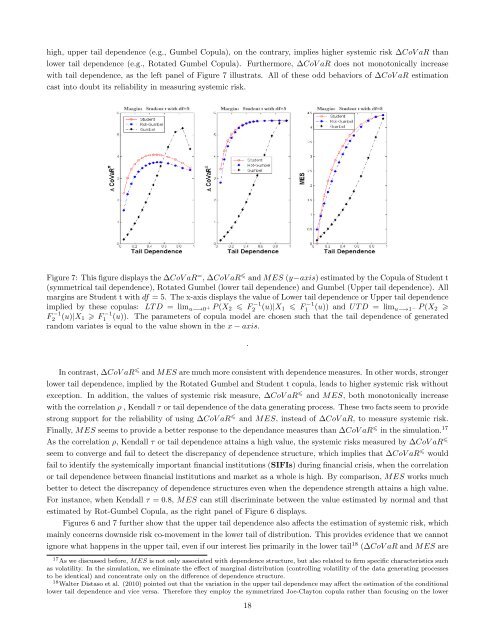Does Tail Dependence Make A Difference In the ... - Boston College
Does Tail Dependence Make A Difference In the ... - Boston College
Does Tail Dependence Make A Difference In the ... - Boston College
You also want an ePaper? Increase the reach of your titles
YUMPU automatically turns print PDFs into web optimized ePapers that Google loves.
high, upper tail dependence (e.g., Gumbel Copula), on <strong>the</strong> contrary, implies higher systemic risk ∆CoV aR than<br />
lower tail dependence (e.g., Rotated Gumbel Copula). Fur<strong>the</strong>rmore, ∆CoV aR does not monotonically increase<br />
with tail dependence, as <strong>the</strong> left panel of Figure 7 illustrats. All of <strong>the</strong>se odd behaviors of ∆CoV aR estimation<br />
cast into doubt its reliability in measuring systemic risk.<br />
Figure 7: This figure displays <strong>the</strong> ∆CoV aR = , ∆CoV aR and MES (y−axis) estimated by <strong>the</strong> Copula of Student t<br />
(symmetrical tail dependence), Rotated Gumbel (lower tail dependence) and Gumbel (Upper tail dependence). All<br />
margins are Student t with df = 5. The x-axis displays <strong>the</strong> value of Lower tail dependence or Upper tail dependence<br />
implied by <strong>the</strong>se copulas: LT D = lim u−→0 + P (X 2<br />
F2 −1 (u)|X 1 F −1<br />
random variates is equal to <strong>the</strong> value shown in <strong>the</strong> x − axis.<br />
F2 −1 (u)|X 1 F1 −1 (u)) and UT D = lim u−→1 − P (X 2 <br />
1 (u)). The parameters of copula model are chosen such that <strong>the</strong> tail dependence of generated<br />
.<br />
<strong>In</strong> contrast, ∆CoV aR and MES are much more consistent with dependence measures. <strong>In</strong> o<strong>the</strong>r words, stronger<br />
lower tail dependence, implied by <strong>the</strong> Rotated Gumbel and Student t copula, leads to higher systemic risk without<br />
exception. <strong>In</strong> addition, <strong>the</strong> values of systemic risk measure, ∆CoV aR and MES, both monotonically increase<br />
with <strong>the</strong> correlation ρ , Kendall τ or tail dependence of <strong>the</strong> data generating process. These two facts seem to provide<br />
strong support for <strong>the</strong> reliability of using ∆CoV aR and MES, instead of ∆CoV aR, to measure systemic risk.<br />
Finally, MES seems to provide a better response to <strong>the</strong> dependance measures than ∆CoV aR in <strong>the</strong> simulation. 17<br />
As <strong>the</strong> correlation ρ, Kendall τ or tail dependence attains a high value, <strong>the</strong> systemic risks measured by ∆CoV aR <br />
seem to converge and fail to detect <strong>the</strong> discrepancy of dependence structure, which implies that ∆CoV aR would<br />
fail to identify <strong>the</strong> systemically important financial institutions (SIFIs) during financial crisis, when <strong>the</strong> correlation<br />
or tail dependence between financial institutions and market as a whole is high. By comparison, MES works much<br />
better to detect <strong>the</strong> discrepancy of dependence structures even when <strong>the</strong> dependence strength attains a high value.<br />
For instance, when Kendall τ = 0.8, MES can still discriminate between <strong>the</strong> value estimated by normal and that<br />
estimated by Rot-Gumbel Copula, as <strong>the</strong> right panel of Figure 6 displays.<br />
Figures 6 and 7 fur<strong>the</strong>r show that <strong>the</strong> upper tail dependence also affects <strong>the</strong> estimation of systemic risk, which<br />
mainly concerns downside risk co-movement in <strong>the</strong> lower tail of distribution. This provides evidence that we cannot<br />
ignore what happens in <strong>the</strong> upper tail, even if our interest lies primarily in <strong>the</strong> lower tail 18 (∆CoV aR and MES are<br />
17 As we discussed before, MES is not only associated with dependence structure, but also related to firm specific characteristics such<br />
as volatility. <strong>In</strong> <strong>the</strong> simulation, we eliminate <strong>the</strong> effect of marginal distribution (controlling volatility of <strong>the</strong> data generating processes<br />
to be identical) and concentrate only on <strong>the</strong> difference of dependence structure.<br />
18 Walter Distaso et al. (2010) pointed out that <strong>the</strong> variation in <strong>the</strong> upper tail dependence may affect <strong>the</strong> estimation of <strong>the</strong> conditional<br />
lower tail dependence and vice versa. Therefore <strong>the</strong>y employ <strong>the</strong> symmetrized Joe-Clayton copula ra<strong>the</strong>r than focusing on <strong>the</strong> lower<br />
18
















